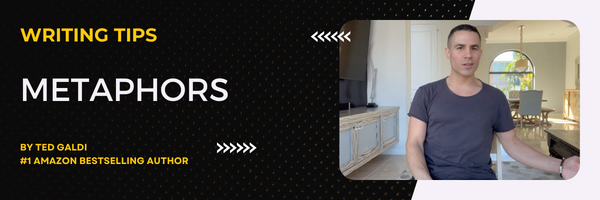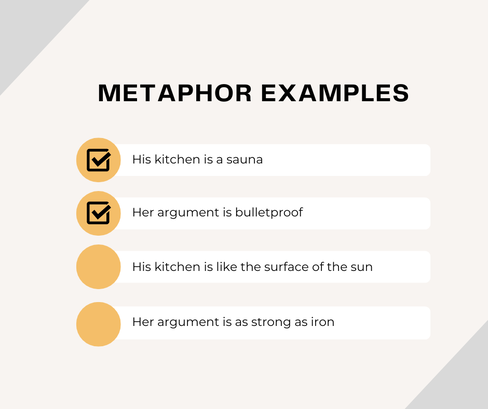Examples of Metaphors [Improve Your Writing]Learn the definition of a metaphor and the different types, see various examples of metaphors, and pick up some tips for adding them to your writing for strong effect. What is a metaphor?A metaphor is a literary device that says one thing is another, even though it's not. Though the two things aren't literally equal, their comparison is true in a figurative sense. Metaphors are often used to make a point in a vivid, exaggerated way. Examples of metaphorsHere are 10 examples of metaphors:
What are the different types of metaphors?Direct metaphorsDirect metaphors directly state that thing A is thing B. For example, "His kitchen" (thing A) "is" "a sauna" (thing B). Thing A and B are linked by a variation of the "be" verb, such as "is," "are," or "was." Implied metaphorsImplied metaphors compare thing A to thing B without specifically stating thing A. Instead, some characteristic of thing A is mentioned. For example, with "Just before our meeting, Lawrence detonated a bomb," thing B would be "a bomb." The metaphor is implying that thing A is some piece of information Lawrence mentioned concerning the meeting. Though "piece of information" is not in the sentence, the metaphor makes sense in an implied way. Abstract metaphorsAbstract metaphors compare thing A to thing B without specifically comparing the two things at all, but rather, making an association between them. You tend to find them in long-form stories, like novels or films. Consider the phrase "X is a metaphor for Y," which is often used to describe some part of a story. For instance, Pete getting lost in the woods is a metaphor for his career struggles. The writer does not have to explicitly state this connection. Instead, the writer can simply create a parallel between the two things, letting the audience make the connection. For example, the way Stanley behaves in the office during a confusing day can be similar to how he behaves in the woods. Sustained metaphorsSustained metaphors compare thing A to thing B, then extend the comparison over multiple sentences, paragraphs, or even an entire story. For example, with "Marissa is the queen of her suburban town," an extended metaphor could further depict Marisa as a queen in the following sentences, "She reigns over PTA meetings and cocktail parties. Any local woman who wants to be socially connected, must bow to her." What is the difference between a metaphor and a simile?These two writing tools are often mixed up. They are quite alike, but with a key difference. With a metaphor, you say that one thing is another. For instance, "his kitchen is a sauna." With a simile, you also compare one thing to another, however not as directly. You don't plainly say one is another, rather that it's similar to another. A word like "is" can still be used, however, a word such as "like" or "as" goes with it. Some examples of similes:
Tips for writing metaphorsIf you happen to be interested in narrative writing, such as writing a short story, novel, or screenplay, metaphors can be a very powerful technique. Here are three tips for applying them to narrative writing: 1. Use direct and implied metaphors for descriptions and dialogueA great description creates a vivid image in a reader's mind. However, if a writer eats up multiple pages describing a single character, place, object, etc, the motion of the story can come to a standstill. Readers may get bored, even if the language is colorful. A metaphor is a great tool for creating a vibrant description without using hundreds of words. Let's say thing A is a character in your story your audience hasn't yet met. If you choose something for thing B that your audience already understands, you can immediately give thing A characteristics of thing B. For example, if a character named Stanley has an odor problem, here's how you can get across that trait with a metaphor: Stanley sits next to me at the kitchen table. When he reaches for the salad bowl, the stench of a dumpster hits me. Metaphorical writing for dialogue enables characters to get across strong points quickly. For example, let's say a character, Fred, is considered a bad dancer. Here's how that could come out in dialogue: Jack, in the passenger seat, asks, "How was that club you and Fred went to last night?" "The place was all right," Al says. "But I had to keep my distance from him once he got out on the dance floor. I didn't want people to know I was friends with the guy." "I thought you two were cool?" "He's not a bad dude. But those dance moves. His feet are made of concrete." With dialogue, not only can a metaphor help describe a person or thing a character is talking about, but it can help characterize the one doing the talking. In just a few words, Al not only expresses Fred's bad dancing, but expresses his own sarcasm. 2. Use abstract, sustained metaphors for emotional impactAbstract, sustained metaphors can be used to add emotional depth to certain parts of your story. For instance, let's say a character, Ethan, has been struggling to mend a relationship with his rebellious son. No matter how hard Ethan tries, he can't seem to gain his son's attention. Panic grips Ethan. He comes to believe the relationship is over. The audience, who identifies with Ethan, is rooting for the relationship to be fixed. Ethan, still upset about his son, decides to take a swim in the ocean to relax. Unfortunately, he's caught in a bad current. No matter how hard he tries, he can't seem to win the fight against the water. Panic grips him. He comes to believe he's going to drown. The sense of panic connects his relationship with his son to the potential drowning. This connection is abstract - the writer doesn't explicitly state it on the page. Then, a stranger tosses Ethan a life preserver. Someone saving Ethan from drowning foreshadows that someone may enter his life and save the relationship between him and his son. The emotional impact of Ethan getting saved will be twofold - the audience will be happy he's alive, and hopeful he repairs his relationship with his son. 3. Avoid mixed metaphors and dead metaphorsA mixed metaphor compares thing A with thing B, then starts incorrectly associating characteristics with B. For example, "Her singing voice was velvet. The way she said the lyrics, knocked the audience out of their seats." "Her singing voice" (thing A) is first compared to "velvet" (thing B). However, something that "knocked the audience out of their seats" doesn't seem like velvet, which is soft. Though knocking the audience out of their seats can surely be associated with good singing, it is incorrectly associated with an already-established element of the metaphor, velvet. A dead metaphor is a cliche metaphor. Audiences have been exposed to them plenty of times. Instead of exposing them again, try to come up with a new way to make the same point. For instance, "He's a tyrant" has been used many times to describe a strict person. To describe a character with this trait, think of another metaphor. For example, "If his son missed a single chore, for the next two weeks, the kid's bedroom would be a max-security prison cell." Want more writing tips?You might also like my articles on alliteration examples, definition of personification, and symbolism in writing.
1 Comment
|



 RSS Feed
RSS Feed